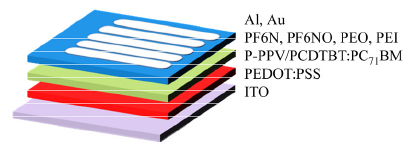| [1] Huang, F.; Wu, H.; Cao, Y. Chem. Soc. Rev. 2010, 39, 2500. [2] Wu, H.; Huang, F.; Mo, Y.; Yang, W.; Wang, D.; Peng, J.; Cao, Y. Adv. Mater. 2004, 16, 1826. [3] Niu, Y.-H.; Ma, H.; Xu, Q.; Jen, A. K.-Y. Appl. Phys. Lett. 2005, 86, 083504. [4] Zhong, C.; Duan, C.; Huang, F.; Wu, H.; Cao, Y. Chem. Mater. 2011, 23, 326. [5] Huang, F.; Wu, H.; Wang, D.; Yang, W.; Cao, Y. Chem. Mater. 2004, 16, 708. [6] Guo, T.-F.; Yang, F.-S.; Tsai, Z.-J.; Wen, T.-C.; Hsieh, S.-N.; Fu, Y.-S. Appl. Phys. Lett. 2005, 87, 013504. [7] Niu, X.; Qin, C.; Zhang, B.; Yang, J.; Xie, Z.; Cheng, Y.; Wang, L. Appl. Phys. Lett. 2007, 90, 203513. [8] Xiong, T.; Wang, F.; Qiao, X.; Ma, D. Appl. Phys. Lett. 2008, 93, 123310. [9] Lu, H. H.; Ma, Y. S.; Yang, N. J.; Lin, G. H.; Wu, Y. C.; Chen, S. A. J. Am. Chem. Soc. 2011, 133, 9634. [10] Seo, J. H.; Gutacker, A.; Sun, Y.; Wu, H.; Huang, F.; Cao, Y.; Scherf, U.; Heeger, A. J.; Bazan, G. C. J. Am. Chem. Soc. 2011, 133, 8416. [11] Zhang, K.; Liu, S.; Guan, X.; Duan, C.; Zhang, J.; Zhong, C.; Wang, L.; Huang, F.; Cao, Y. Sci. China Chem. 2012, 55, 766. [12] Zhou, Y.; Fuentes-Hernandez, C.; Shim, J.; Meyer, J.; Giordano, A. J.; Li, H.; Winget, P.; Papadopoulos, T.; Cheun, H.; Kim, J.; Fenoll, M.; Dindar, A.; Haske, W.; Najafabadi, E.; Khan, T. M.; Sojoudi, H.; Barlow, S.; Graham, S.; Bredas, J.-L.; Marder, S. R.; Kahn, A.; Kippelen, B. Science 2012, 336, 327. [13] Huang, F.; Hou, L.; Wu, H.; Wang, X.; Shen, H.; Cao, W.; Yang, W.; Cao, Y. J. Am. Chem. Soc. 2004, 126, 9845. [14] Wu, H.; Huang, F.; Peng, J.; Cao, Y. Org. Electron. 2005, 6, 118. [15] Huang, F.; Shih, P.-I.; Shu, C.-F.; Chi, Y.; Jen, A. K.-Y. Adv. Mater. 2009, 21, 361. [16] Zeng, W. J.; Wu, H. B.; Zhang, C.; Huang, F.; Peng, J. B.; Yang, W.; Cao, Y. Adv. Mater. 2007, 19, 810. [17] He, Z.; Zhong, C.; Huang, X.; Wong, W. Y.; Wu, H.; Chen, L.; Su, S.; Cao, Y. Adv. Mater. 2011, 23, 4636. [18] Yang, T.; Wang, M.; Duan, C.; Hu, X.; Huang, L.; Peng, J.; Huang, F.; Gong, X. Energy Environ. Sci. 2012, 5, 8208. [19] He, Z.; Zhong, C.; Su, S.; Xu, M.; Wu, H.; Cao, Y. Nat. Photon. 2012, 6, 593. [20] Liao, S. H.; Li, Y. L.; Jen, T. H.; Cheng, Y. S.; Chen, S. A. J. Am. Chem. Soc. 2012, 134, 14271. [21] Lan, L.; Peng, J.; Sun, M.; Zhou, J.; Zou, J.; Wang, J.; Cao, Y. Org. Electron. 2009, 10, 346. [22] Seo, J. H.; Namdas, E. B.; Gutacker, A.; Heeger, A. J.; Bazan, G. C. Adv. Funct. Mater. 2011, 21, 3667. [23] Hsu, B. B.; Duan, C.; Namdas, E. B.; Gutacker, A.; Yuen, J. D.; Huang, F.; Cao, Y.; Bazan, G. C.; Samuel, I. D. W.; Heeger, A. J. Adv. Mater. 2012, 24, 1171. [24] Hsiao, C. C.; Hsiao, A. E.; Chen, S. A. Adv. Mater. 2008, 20, 1982. [25] Chen, J.; Shi, C.; Fu, Q.; Zhao, F.; Hu, Y.; Feng, Y.; Ma, D. J. Mater. Chem. 2012, 22, 5164. [26] Zhang, F.; Ceder, M.; Inganäs, O. Adv. Mater. 2007, 19, 1835. [27] Kang, H.; Hong, S.; Lee, J.; Lee, K. Adv. Mater. 2012, 24, 3005. [28] Guan, X.; Zhang, K.; Huang, F.; Bazan, G. C.; Cao, Y. Adv. Funct. Mater. 2012, 22, 2846. [29] Wang, Q.; Zhou, Y.; Zheng, H.; Shi, J.; Li, C.; Su, C. Q.; Wang, L.; Luo, C.; Hu, D.; Pei, J.; Wang, J.; Peng, J.; Cao, Y. Org. Electron. 2011, 12, 1858. [30] Shewchun, J.; Dubow, J.; Myszkowski, A.; Singh, R. J. Appl. Phys. 1978, 49, 855. [31] Shewchun, J.; Singh, R.; Green, M. A. J. Appl. Phys. 1977, 48, 765. [32] Na, S.-I.; Kim, T.-S.; Oh, S.-H.; Kim, J.; Kim, S.-S.; Kim, D.-Y. Appl. Phys. Lett. 2010, 97, 223305. [33] Brabec, C. J.; Cravino, A.; Meissner, D.; Sariciftci, N. S.; Fromherz, T.; Rispens, M. T.; Sanchez, L.; Hummelen, J. C. Adv. Funct. Mater. 2001, 11, 374. [34]Niu, Y.-H.; Jen, A. K.-Y.; Shu, C.-F. J. Phys. Chem. B 2006, 110, 6010. |
